The decision of which self-defense .410 firearm is the correct choice for up-close-and-personal situations encountered in the home often comes down to a handgun in one hand or a short-barreled pump-action shotgun in the other. Because of their ease of handling, two revolvers that are capable of firing both .410 loads and handgun rounds are becoming quite popular; and pistol-grip short-barrel shotguns remain a favored option in self-defense circles. The question arises about which type of close-range firearm is the most effective with the diminutive .410 loads, including those that have recently been developed with short-barreled revolvers in mind.
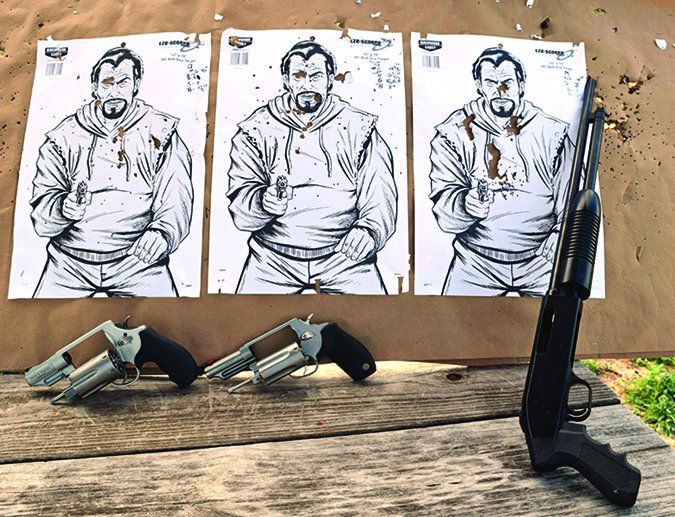
Acting on a reader request, we conducted a multitude of tests on a trio of readily available self-defense firearms that included a Taurus Judge (handles .410-bore shotshells and 45 Colt) that retails for $629; a Smith & Wesson Governor (handles .410, 45 Colt, and 45 ACP) that retails for $809; and a Mossberg Model 500 Cruiser that sells for $467 and fires .410-bore shotshells.
Each of the firearms (all have been examined in previous GT reviews) is specifically designed for close-quarters action, such as when an intruder has illegally entered a residence, placing the people living in the home in a potentially life-threatening situation. In such a life-or-death scenario, a reliable, easy-to-handle, and effective self-defense tool is essential.
In this part of the GT evaluation and match-up, our focus was on the handling ability of the three firearms and their patterning performance at close-quarters ranges. We attempted to walk the fine line that divides ease of handling with putting the pattern in the right place to evaluate the two revolvers and the pump-action.
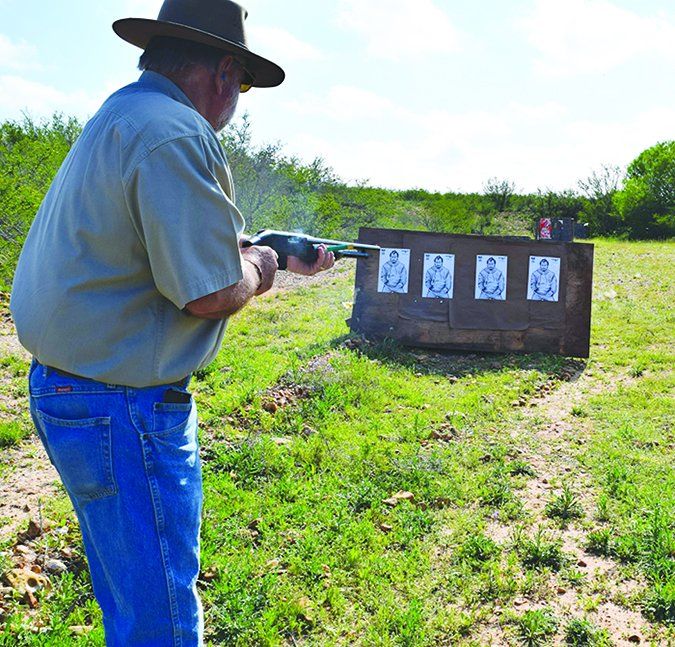
Additional testing of the trio will cover the punch factor of whether there is a significant difference between the energy delivered on the target when the rounds are fired through short-barreled handguns or down the 18.5-inch barrel of the pump-action shotgun.
Up close and personal with a home intruder is not the time to be concerned about whether a home-defense firearm is packing enough punch.
Being able to deliver an effective, accurate and deadly shot into a threat or threats is the paramount factor in any home-defense situation, although this must be weighed against whether or not the homeowner is able to easily handle the firearm. In recent years, that factor has often centered on the use of a .410 by the home defender.
The tiny popper has been around for a long time on skeet fields or in hunting situations; and is often mistakenly used as an introductory gauge for beginning shooters. At typical clay and live target ranges, the diminutive .410 throws an unforgiving pattern — there is no room for error like with a 12, 20, or even a 28 gauge. That is why it is considered a pro’s shotgun, not a beginner’s tool, in most wingshooting circles.
However, there is less recoil with the .410, and that factor seems to be the main reason for its regular use both in the field and for home defense.
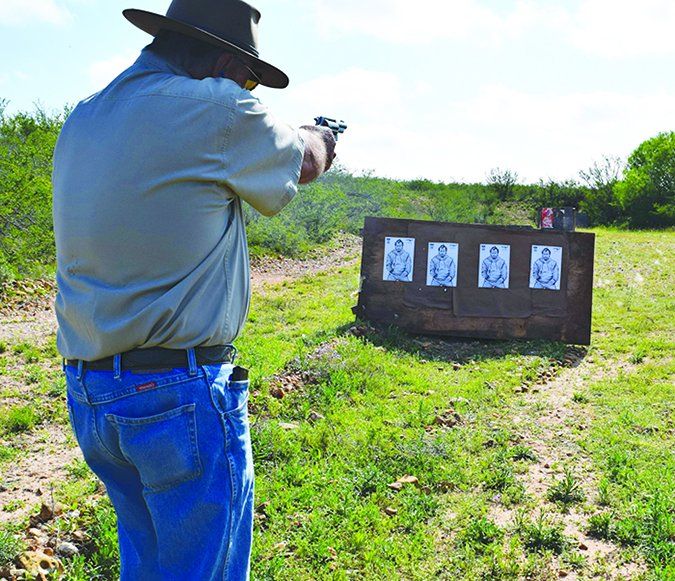
The idea seems to be that an inexperienced shooter facing an intruder will have an easier time wielding the .410 in a life-or-death situation than a heavier, harder-kicking 12 or 20 gauge.
This concept has led to the development of revolvers designed to handle the .410 loads and their being promoted as good choices for home-defense situations.
When a Gun Tests reader contacted us asking for a comparison of the revolvers versus the most recommended home-defense firearm — a short barreled, pump-action shotgun — we managed to get our hands on several representative models for a head-to-head-to-head comparison.
The price difference between the two revolvers was relatively small, with both handguns well above the retail price of the pump-action shotgun. We believe the capability of the two pistols to fire handgun loads was most likely a key factor in their heftier price tags.
To cover a variety of loads that might be used in a close-range, self-defense situation, the ammunition we selected for our testing included: Federal Premium 2.5-inch, 000 buckshot (four pellets) with an average muzzle velocity of 850 fps; Remington Express XLR 2.5-inch one-half ounce No. 6 shot with an average muzzle velocity of 1250 fps; Winchester PDX1 Defender 2.5-inch loads containing three plated defense discs and 12 plated BBs with an average muzzle velocity of 750 fps; and Winchester 2.5-inch hollow-point rifled slugs (one-fifth ounce) with an average muzzle velocity of 1830 fps. In addition, our handguns loads for the two revolvers included Hornady Critical Defense FTX 45 Colt, 185-grain loads with an average muzzle velocity of 950 fps and Barnes TacXPD 45 Auto +P, 185-grain loads with an average muzzle velocity of 1000 fps.
We tested the firearms on the range with targets set at two ranges used in concealed carry courses to simulate typical home-defense scenarios. The close targets were set at 9 feet (3 yards) and the second set of targets was shot at 21 feet (7 yards). Here are our findings:
Smith & Wesson Governor .410, 45 Colt, & 45 ACP, $809
GUN TESTS GRADE: A
Good feel, solid heft, nice trigger, and very nice patterning performance at close-quarter targets moved the S&W to the top of our list. We liked the way it pointed and how it could be quickly brought onto targets packing a variety of shotgun loads and two different handgun rounds.
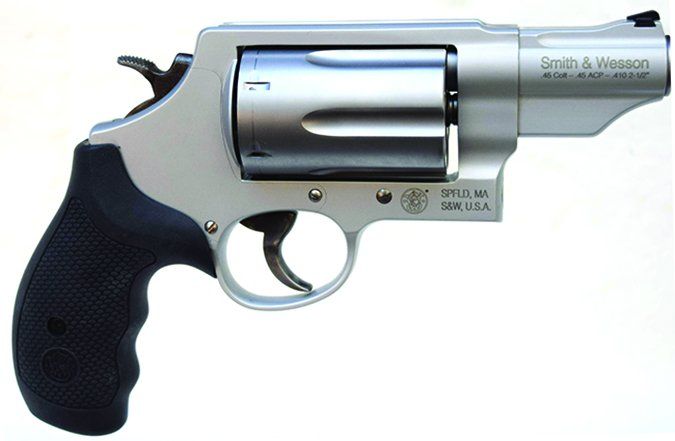
| ACTION TYPE | Revolver |
| CHAMBER SIZE | 2.5 in. (.410) |
| OVERALL LENGTH | 8.5 in. |
| HEIGHT | 5.5 in. |
| CAPACITY | 6 |
| WEIGHT UNLOADED | 30.9 oz. |
| BARREL LENGTH | 2.5 in. |
| BARREL | Stainless steel; 1:15 twist |
| FRAME | Matte silver scandium alloy |
| GRIP | Black synthetic |
| FRONT SIGHT | Black ramp |
| REAR SIGHT | Fixed notch |
| TRIGGER PULL WEIGHT (SA) | 4.75 lbs. |
| TRIGGER PULL WEIGHT (DA) | 11 lbs. |
| WARRANTY | Lifetime |
| TELEPHONE | (800) 331-0852 |
| WEBSITE | Smith-Wesson.com |
| MADE IN | USA |
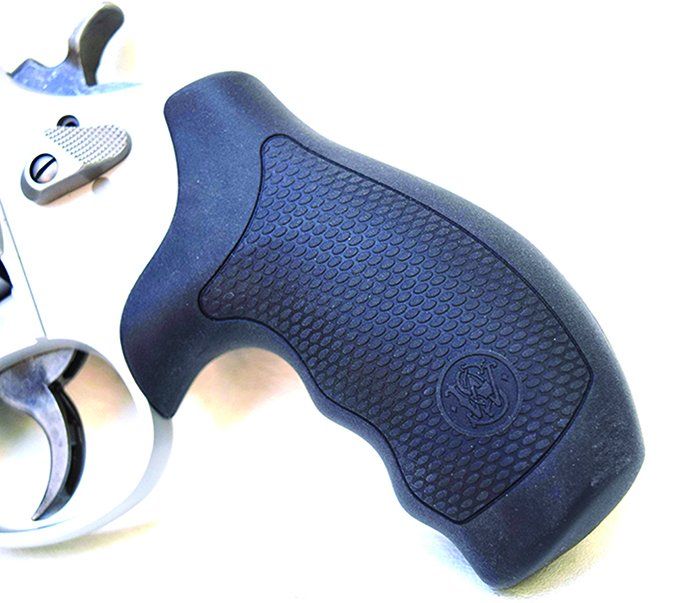
While trying not to go down old trails (the S&W Governor was given an A- rating in its June 2011 GT evaluation), we focused this review on the revolver’s handling ability and patterning performance in home-defense situations.
What we found at first blush is that for a self-defense firearm that will spend most of its time on a nightstand beside a bed, the Governor had the best heft and feel of the review trio.
Slightly lighter than the Taurus Judge we matched it against — weighing in at 30.9 ounces — the Governor was a better-balanced handgun and was also easier to bring to bear onto a target than the hip-shooting Mossberg.
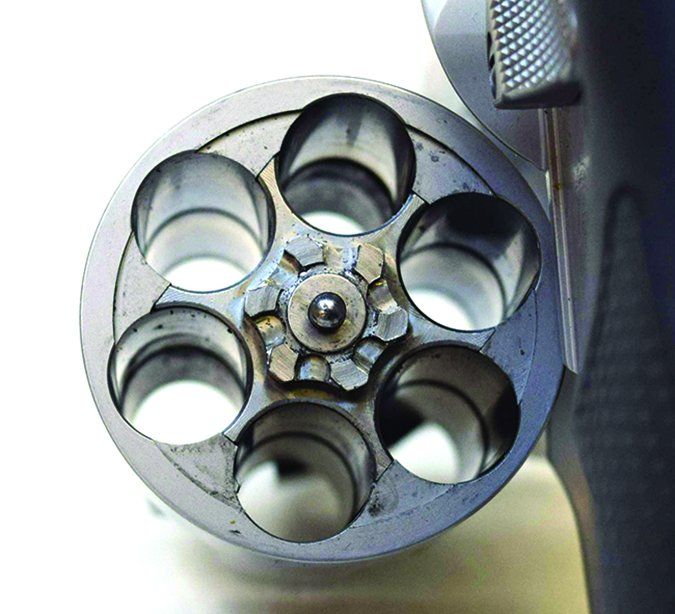
Featuring a six-shot cylinder rather than the five-shot cylinder in the Judge, which made the Governor just a touch wider, we found the feel of the firearm to be very nice. When a handgun fits the hand well and feels good, that really helps a shooter be on target.
We also appreciated the textured synthetic grip and the deeply rounded trigger of the Governor. During the range time, these comfort factors were a major contributing factor to the Governor’s accuracy with all the test loads.
With a 2.5-inch barrel, the Governor was a half-inch shorter than the Judge, measuring 8.5 inches in length. Having an overall height advantage of one half-inch (5.5 inches), along with a slightly larger width, we found the S&W to have a better heft of the two handguns.
We found no faults in the solid design and workmanship in the Governor, although we would have preferred a different front sight. The black ramp tritium insert, while adjustable, was not difficult to see on a target, but did not stand out quite as well as the Judge’s red fiber-optic sight.
The trigger pull of the Governor was a crisp 4.75 pounds in single action and 11 pounds in double action. While the double-action pull was a little long for our tastes, it was very smooth. The cylinder also turned smoothly with a solid click as the handgun came into battery. The action was very similar to large-caliber S&W revolvers that have found favor with many handgunners.
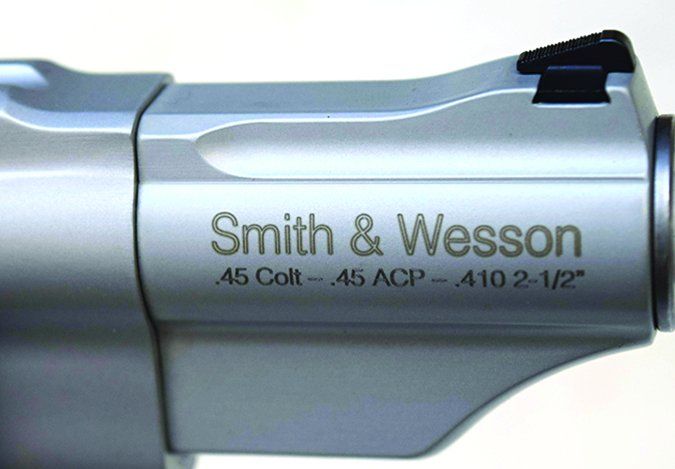
Moving onto the shooting range, the Governor produced results that were quite impressive.
Fired at targets set nine feet down range, the Governor produced its best pattern of 10 inches across with the Remington No. 6 shotshells; a 5-inch group with the Winchester PDX1 Defender loads containing three plated defense discs and 12 plated BBs; a 1.5-inch group with the Federal Premium 000 (four pellets) buck shot; and a perfect center mass hit with the Winchester one-fifth ounce hollow-point slug.
Each of the hits with the various loads would have been what we would consider a man stopper.
Recoil with all the loads was surprisingly mild, which we attributed to the high quality heft and feel of the revolver.
Moving back to 21 feet, the spread of the No. 6 shot increased to an average of 16.5 inches; the Defender load spread was eight inches; and the 000 buckshot spread was 3.5 inches. The slug shot was still dead center in the chest of the target.
Once again, all were what we would consider an effective and deadly group for a home defense firearm.
Since the Governor was also capable of handling both 45 Colt and 45 ACP rounds (three two-round moon clips and two six-round moon clips are included in the Governor package), we also sent a few rounds downrange to check out the handgun’s accuracy.
The best 45 ACP three-shot group of 1.5 inches from center to center at both 9 feet and 21 feet was considered exceptional for a short-barreled handgun. The 45 Colt three-shot groups came in at 1.5 inches at 9 feet and 3 inches at 21 feet, which was also considered above adequate for a revolver with a 2.5-inch barrel.
Because of the variety of loads the Governor handles well, a 000 buckshot, followed by a Defender load, followed by two 45 Colt rounds, followed by two 45 ACP loads might be considered a hard combination to beat.
Our Team Said: Although the price tag of the Smith & Wesson was the highest among our three firearms, its accuracy at close-quarter, self-defense ranges; handling ability and crisp trigger pull, plus the revolver’s capability to handle a variety of loads moved it to the top of our list. We found the recoil from all the loads was well within the acceptable range.
Taurus Judge .410 & .45 Colt, $629
GUN TESTS GRADE: B
While the Judge provided what we would consider acceptable close-range performance with all loads, the patterning results were below both the Governor and the Mossberg. If price is the key factor in a purchase decision, the Judge would fit the bill of an adequate home-defense firearm.
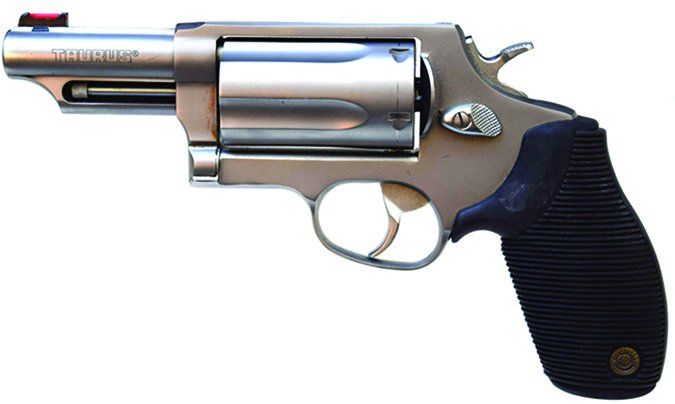
| ACTION TYPE | Revolver |
| CHAMBER SIZE | 2.5 in. (.410) |
| OVERALL LENGTH | 9.5 in. |
| HEIGHT | 5 in. |
| CAPACITY | 5 |
| WEIGHT UNLOADED | 32 oz. |
| BARREL LENGTH | 3 in. |
| BARREL | Matte stainless steel; 1:12 twist |
| FRAME | Matte stainless steel |
| GRIP | Black synthetic |
| FRONT SIGHT | Red fiber optic |
| REAR SIGHT | Fixed notch |
| TRIGGER PULL WEIGHT (SA) | 6 lbs. |
| TRIGGER PULL WEIGHT (DA) | 11.5 lbs. |
| WARRANTY | Unlimited lifetime repair |
| TELEPHONE | (800) 327-3776 |
| WEBSITE | TaurusUSA.com |
| MADE IN | Brazil |
While the Judge provided what we would consider acceptable close-range performance with all loads, the patterning results were below both the Governor and the Mossberg. If price is the key factor in a purchase decision, the Judge would fit the bill of an adequate home-defense firearm.
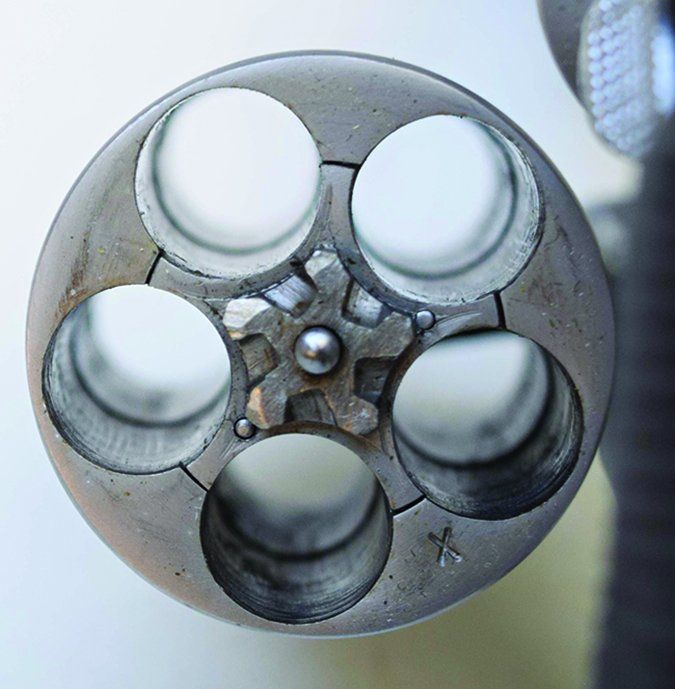
Although reviewed by GT in a slightly different version in August 2009, this examination of the popular hand cannon went into further detail on how it handled and punched holes in paper at self-defense ranges.
Tipping the scales at 32 ounces, we found that the Judge was slightly muzzle heavy with a 3-inch barrel and did not feel as balanced in the hand as the Governor.
The Taurus does present a smaller profile than the S&W that may be attributed to the five-round cylinder, as opposed to the six shots available in the Governor. One more round is not much of a difference, but it is a difference that we noted.
The overall length of the Judge was 9.5 inches, with a height of 5.0 inches and a 3-inch barrel. Touted as a shock-absorbing “Ribbers” synthetic grip, we found that the feel was a little spongy and we experienced no discernible reduction in recoil compared to the grip on the Governor.
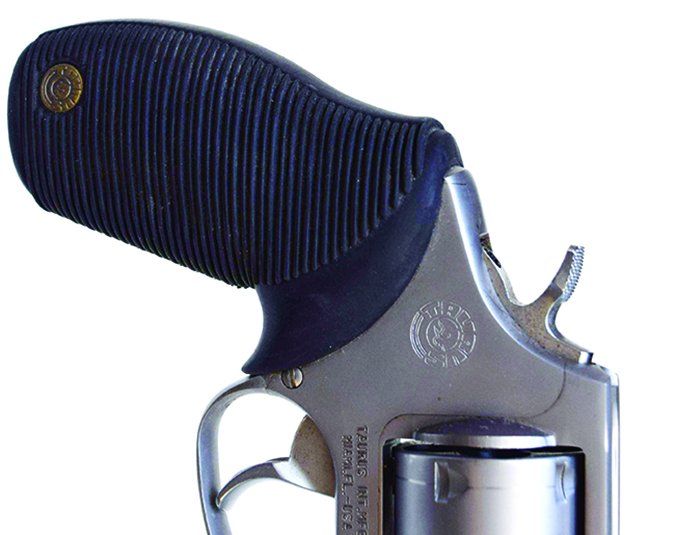
The matte-stainless-steel finish was not quite as sharp and distinctive as the finish on the Governor, which cost the Judge a few appearance points. We did like the red-optic front sight that offered a good sight alignment through the square-notch rear sight — in good light. In low-light conditions like those that might be found in a home at night, we found there was little difference between the S&W and the Judge.
While the S&W trigger and hammer were blued with a very good feel, we found the stainless trigger and hammer of the Judge were just not as comfortable to use. Not a big difference, but enough to note.
The trigger pull of the Judge was 6 pounds in single action and 11.5 pounds in double action, with a slight creep during the long pull. We also noticed the Judge was not as smooth firing in double action, and it did not feel as solid when the cylinder turned as when we shot DA with the Governor.
At the shooting range, the Judge fell a little behind the Governor in performance with every load. Firing at targets set down range at nine feet, the Judge’s best pattern spread with the No. 6 shot was 13.5 inches; a 6.5-inch spread with the Defender load; a 4-inch spread with the 000 buckshot; and the slug hit about 2 inches above the hold point in the center of the chest.
As with the Governor, we felt the patterns were acceptable for close range home-defense situations.
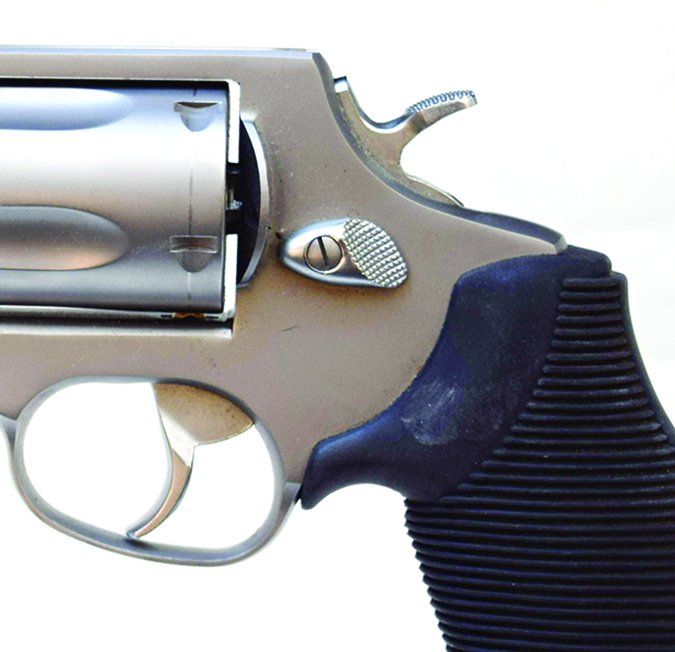
Moving out to 21 feet resulted in an 18.5-inch spread with the No. 6 shot; a 3-inch-high spread of 8.5 inches with the Defender load; a three-inch-high spread of 10 inches with the 000 buckshot; and an off-the-the target high hit (about 12 inches above the hold point) with the slug. Overall, we felt this was a barely satisfactory performance.
With the handgun load of 45 Colt, the best three-shot groups were 2 inches at 9 feet and 8 inches at 21 feet. While still within the realm of potential man-stopping hits, the performance fell below that of the Governor.
Our advice for those using the Judge in a home-defense situation is to avoid the No. 6 or any other bird shot. A good combination would be a couple of Defender loads, a couple 000 buckshot loads, and a 45 Colt round as the final shot.
Our Team Said: Slightly greater recoil, balance not equal to the S&W, and less-than-stellar accuracy results with all loads were the factors in ranking the Judge as third in a three-way race. However, if price is the major deciding factor in selecting a home-defense handgun, we would consider the Judge to be an acceptable selection.
Mossberg Model 500 Cruiser .410 Pump-Action, $467
GUN TESTS GRADE: B
Although tight patterns at close range can be both good and bad, depending upon the skill level of the shooter, we were impressed with the handling ability of the shotgun. Recoil when shot from the hip was not a problem with any of the test loads.

| ACTION TYPE | Pump |
| CHAMBER SIZE | 2.5 to 3 in. |
| OVERALL LENGTH | 28.5 in. |
| HEIGHT | 6 in. |
| CAPACITY | 5+1 |
| WEIGHT UNLOADED | 4.5 lbs. |
| BARREL LENGTH | 18.5 in. |
| BARREL | Blued |
| RECEIVER | Flat black |
| CHOKE | Cylinder |
| BUTTSTOCK | Black synthetic pistol grip |
| FOREARM | Black synthetic ribbed |
| FOREARM LENGTH | 7 in. |
| FRONT SIGHT | Brass bead |
| REAR SIGHT | None |
| TRIGGER PULL WEIGHT | 5.5 lbs. |
| WARRANTY | 2-year limited |
| TELEPHONE | (800) 363-3555 |
| WEBSITE | Mossberg.com |
| MADE IN | USA |
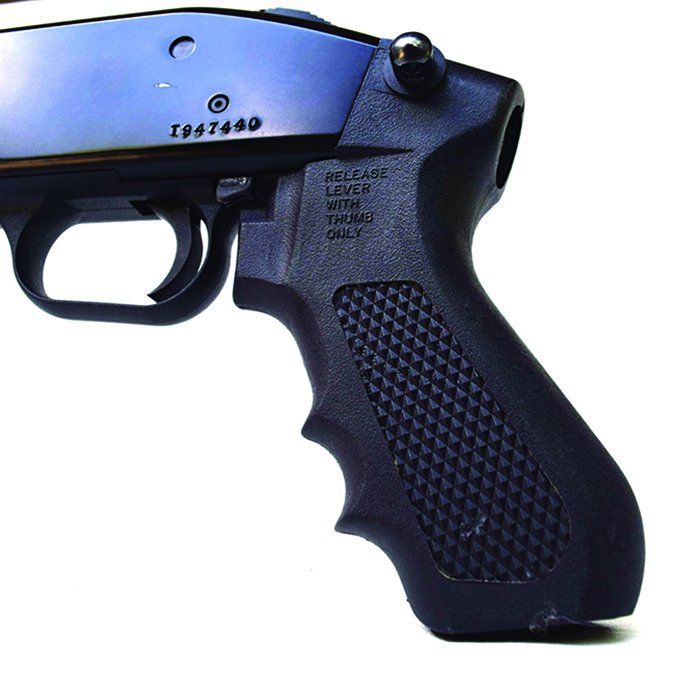
If shooting a low-recoil shotgun from the hip is your game, the diminutive .410 pump may be just what fulfills your needs as a homeowner interested in a good close-quarter defense firearm. Mossberg has been manufacturing what many have found are solid, dependable pump-action shotguns for decades, although .410 tactical firearms are relatively new to the market.
The model we tested in this self defense trio (the Mossberg was also reviewed by GT in October 2012) is designed to be compact and easy to handle, particularly by an inexperienced shooter. Weighing just 4.5 pounds (unloaded) with an overall length of 28.5 inches and sporting an 18.5-inch barrel, we found the shotgun was quite easy to bring to bear on close-range targets.
However, we did have a concern about how a very inexperienced shooter might be at a disadvantage in a self-defense situation if he or she has no way to align the sight on a target. We would recommend that anyone who might be put into self-defense service spend some quality time on the range adjusting to hip or chest shooting.
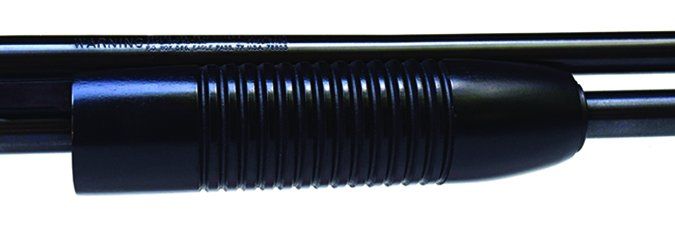
The trigger pull of the Mossberg was 5.5 pounds, which is quite typical for an out-of-the box shotgun. A little lighter would be better, in our opinion. Like the other Mossberg pump-actions, the safety is located on top of the receiver — we liked this feature — to allow for quick and easy access.
However, the action-release button is tucked up behind the left side of the trigger guard and can be a little difficult to operate, particularly in a speed mode or when under pressure.
We found the feel of the Mossberg Cruiser’s synthetic pistol grip and forearm to be slightly less comfortable than the feel of either of the handguns. We thought the plastic was just a little slick to the touch.
While chambered for 3-inch shells, we limited our range time to the 2.5-inch loads to maintain a proper comparison (the handguns in the test only handle 2.5-inch shotgun shells) in the three-way test.
Firing at the Birchwood Casey Bad Guy Target set 9 feet down range, the best pattern produced by the Mossberg was a 4-inch spread with the No. 6 shot; a two-inch spread with the Defender load; a one-inch spread with the 000 buckshot; and a center punch with the slug.
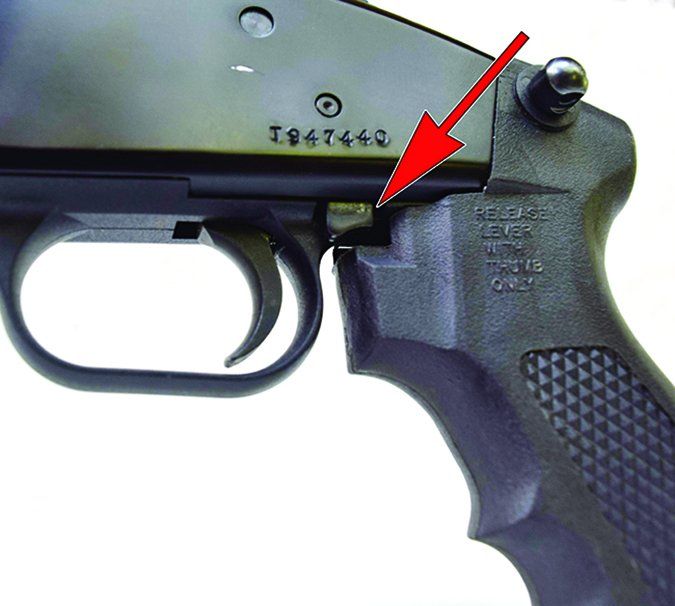
Our only concern was the tight patterns with the No. 6 shot and other pellet loads might result in a missed shot at a close-range intruder. Spreads of from 1 inch to 3 inches leave little room for error.
The experienced shooters in our test group had no problems hitting the close-range target from the hip, but that might not be the case with someone unfamiliar or unpracticed at this type of shooting.
Moving back to 21 feet, the tighter groups with the Mossberg continued to produce satisfactory stopping shots. The best No. 6 shot group was a spread of 8 inches; the Defender spread was 3 inches; the 000 buckshot spread was 2 inches; and the slug hit just slightly high, but close enough to dead center that the results would have been a man-stopper.
As noted earlier, we found that proper shot and slug placement with the Mossberg was harder than when we were able to sight down the barrel of both the handguns.
We did not have any recoil problems with any of the loads fired in the shotgun, and as we experienced with both the handguns, all ammunition was cycled without a hitch.
Our Team Said: Pump-action shotguns produced by Mossberg are among the most popular field and self-defense firearms in the country and this model lived up to that reputation. Good, tight patterns with pellets, plus acceptable handling and functioning, were all reasons for our second-place ranking of the shotgun.
Written and photographed by Ralph Winingham, using evaluations from Gun Tests team testers.


























Yeah is the long firearm that is I’m asking how much how much is it let me know please so that I can send the money for you please